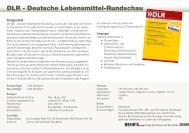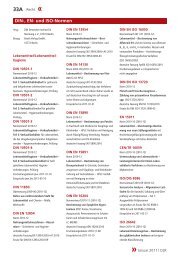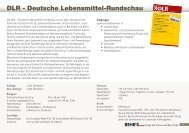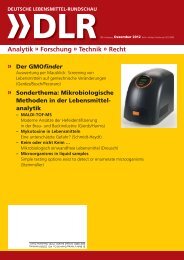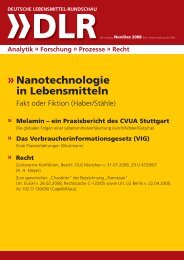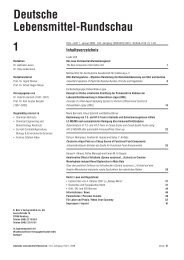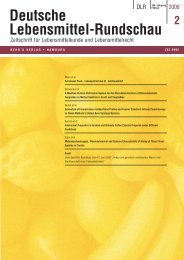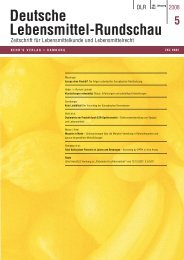Recht - DLR Online
Recht - DLR Online
Recht - DLR Online
Sie wollen auch ein ePaper? Erhöhen Sie die Reichweite Ihrer Titel.
YUMPU macht aus Druck-PDFs automatisch weboptimierte ePaper, die Google liebt.
30) Rubio J et al.: Aqueous and hydroalcoholic extracts of Black Maca (Lepidium<br />
meyenii) improve scopolamine-induced memory impairment in<br />
mice. Food Chem Toxicol 45, 1882–1890 (2007).<br />
31) Zhang Y et al.: Effect of ethanol extract of Lepidium meyenii Walp. on<br />
osteoporosis in ovariectomized rat. J Ethnopharmacol 105, 274–279<br />
(2006).<br />
32) Gonzales C et al.: Effect of short-term and long-term treatments with<br />
three ecotypes of Lepidium meyenii (MACA) on spermatogenesis in rats.<br />
J Ethnopharmacol 103, 448–454 (2006).<br />
33) Gasco M et al.: Dose-response effect of Red Maca (Lepidium meyenii) on<br />
benign prostatic hyperplasia induced by testosterone enanthate. Phytomedicine<br />
14, 460–464 (2007).<br />
34) Bogani P et al.: Lepidium meyenii (Maca) does not exert direct androgenic<br />
activities. J Ethnopharmacol 104, 415–417 (2006).<br />
35) Valerio LG Jr, Gonzales GF: Toxicological aspects of the South American<br />
herbs cat’s claw (Uncaria tomentosa) and Maca (Lepidium meyenii): a<br />
critical synopsis. Toxicol Rev 24, 11–35 (2005).<br />
36) Valentová K et al.: Maca (Lepidium meyenii) and yacon (Smallanthus<br />
sonchifolius) in combination with silymarin as food supplements: in vivo<br />
safety assessment. Food Chem Toxicol 46, 1006–1013 (2008).<br />
37) Gonzales GF et al.: Effect of Lepidium meyenii (Maca), a root with aphrodisiac<br />
and fertility-enhancing properties, on serum reproductive hormone<br />
levels in adult healthy men. J Endocrinol 176, 163–168 (2003).<br />
38) Meissner H et al.: Short and Long-Term Physiological Responses of Male<br />
and Female Rats to Two Dietary levels of Pre-Gelatinized Maca (Lepidium<br />
Peruvianum Chacon). Int J Biomed Sci 2, 15–29 (2006).<br />
39) Frohne D: Heilpflanzen-Lexikon. Wissenschaftliche Verlagsgesellschaft<br />
mbH, Stuttgart (2002).<br />
40) Gauthaman K, Ganesan AP: The hormonal effects of Tribulus terrestris<br />
and its role in the management of male erectile dysfunction – an evaluation<br />
using primates, rabbit and rat. Phytomedicine 15, 44–54 (2008).<br />
41) Neychev VK, Mitev VI: The aphrodisiac herb Tribulus terrestris does not<br />
influence the androgen production in young men. J Ethnopharmacol 101,<br />
319–323 (2005).<br />
42) Saudan C et al.: Short term impact of Tribulus terrestris intake on doping<br />
control analysis of endogenous steroids. Forensic Sci Int 178, e7–e10<br />
(2008).<br />
43) Rogerson S et al.: The effect of five weeks of Tribulus terrestris supplementation<br />
on muscle strength and body composition during preseason<br />
training in elite rugby league players. J Strength Cond Res 21, 348–353<br />
(2007).<br />
44) Poprzecki S et al.: Ergogenic effects of Tribulus terrestris supplementation<br />
in men. J Hum Kinet 13, 41–50 (2005).<br />
45) Mannhart C: Aktuelle Leistungsförderer im Sport. Schweiz Ztg Sportmed<br />
Sporttraumatol 51, 58–79 (2003).<br />
46) Kreider RB et al.: ISSN Exercise & Sport Nutrition Review: Research &<br />
Recommendations. Sports Nutr Rev J 1, 1–44 (2004).<br />
47) Bucci LR: Selected herbals and human exercise performance. Am J Clin<br />
Nutr 72, 624S–636S (2000).<br />
48) Basch E et al.: Therapeutic applications of fenugreek. Altern Med Rev 8,<br />
20–27 (2003).<br />
49) Ikeuchi M et al.: Effects of fenugreek seeds (Trigonella foenum greaecum)<br />
extract on endurance capacity in mice. J Nutr Sci Vitaminol (Tokyo)<br />
52, 287–292 (2006).<br />
50) Arzneimittelgesetz in der Fassung der Bekanntmachung vom 12. Dezember<br />
2005: BGBl. I 3394, zuletzt geändert am 23. November 2007 (BGBl. I<br />
S. 2631) (2005).<br />
51) Hampl R et al.: 7-Hydroxydehydroepiandrosterone – a natural antiglucocorticoid<br />
and a candidate for steroid replacement therapy? Physiol Res<br />
49 (Suppl 1), S107–S112 (2000).<br />
52) Shi J, Schulze S, Lardy HA: The effect of 7-oxo-DHEA acetate on memory<br />
in young and old C57BL/6 mice. Steroids 65, 124–129 (2000).<br />
53) Jung F, Scherges M, Fürst P: Illegale und gefälschte Wachstumshormonpräparate.<br />
Dtsch Apoth Ztg 142, 50–61 (2002).<br />
54) Liu H et al.: Systematic Review: The Effects of Growth Hormone on Athletic<br />
Performance. Ann Int Med 148, 747–758 (2008).<br />
55) Avins AL et al.: A detailed safety assessment of a saw palmetto extract.<br />
Complement. Ther Med 16, 147–154 (2008).<br />
56) Avins AL, Bent S: Saw palmetto and lower urinary tract symptoms: what<br />
is the latest evidence? Curr Urol Rep 7, 260–265 (2006).<br />
57) Bent S et al.: Saw palmetto for benign prostatic hyperplasia. N Engl J<br />
Med 354, 557–566 (2006).<br />
58) Ulbricht C et al.: Evidence-based systematic review of saw palmetto by<br />
the Natural Standard Research Collaboration. J Soc Integr Oncol 4, 170–<br />
186 (2006).<br />
59) Brown GA et al.: Effects of anabolic precursors on serum testosterone<br />
concentrations and adaptations to resistance training in young men. Int J<br />
Sport Nutr Exerc Metabol 10, 340–359 (2000).<br />
60) Brown GA et al.: Endocrine and Lipid Responses to Chronic Androstenediol-Herbal<br />
Supplementation in 30 to 58 Year Old Men. J Am Coll Nutr<br />
20, 520–528 (2001).<br />
61) Pugalenthi M, Vadivel V, Siddhuraju P: Alternative food/feed perspectives<br />
of an underutilized legume Mucuna pruriens var. utilis – a review. Plant<br />
Foods Hum Nutr 60, 201–218 (2005).<br />
62) Modi KP, Patel NM, Goyal RK: Estimation of L-dopa from Mucuna pruriens<br />
LINN and formulations containing M. pruriens by HPTLC method.<br />
Chem Pharm Bull (Tokyo) 56, 357–359 (2008).<br />
63) Siddhuraju P, Becker K: Rapid reversed-phase high performance liquid<br />
chromatographic method for the quantification of L-Dopa (L-3,4-dihydroxyphenylalanine),<br />
non-methylated and methylated tetrahydroisoquinoline<br />
compounds from Mucuna beans. Food Chem 72, 389–394 (2001).<br />
64) Katzenschlager R et al.: Mucuna pruriens in Parkinson’s disease: a double<br />
blind clinical and pharmacological study. J Neurol Neurosurg Psychiatry<br />
75, 1672–1677 (2004).<br />
65) Manyam BV, Dhanasekaran M, Hare TA: Effect of antiparkinson drug HP-<br />
200 (Mucuna pruriens) on the central monoaminergic neurotransmitters.<br />
Phytother Res 18, 97–101 (2004).<br />
66) AIS Supplement Group Classification: Australian Institute of Sport,<br />
http://www.ausport.gov.au/ais/nutrition/supplements/classifications (Zugriff<br />
am 24.06.2008) (2008).<br />
422 ı Originalarbeiten Deutsche Lebensmittel-Rundschau ı 104. Jahrgang, Heft 9, 2008




